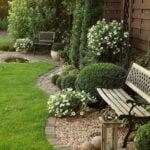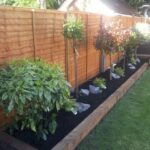Are you considering starting a kitchen herb garden? If so, have you thought about the design layout, such as a spiral pattern? A well-designed kitchen herb garden can be both functional and beautiful. In this article, we will explore the concept of a kitchen herb garden and the benefits of having one, as well as tips for creating a spiral design layout that is both visually appealing and space-efficient.
A kitchen herb garden offers numerous advantages to any home cook. Not only does it provide easy access to fresh herbs for cooking, but it also adds greenery and fragrance to your kitchen space.
Additionally, growing your own herbs can save money and reduce food waste by allowing you to harvest only what you need when you need it. A well-planned spiral design layout can maximize space in both indoor and outdoor kitchens, making it an ideal option for those with limited gardening real estate.
In the following sections, we will discuss choosing the right location for your kitchen herb garden, selecting the best herbs for your spiral design layout, designing and planning the layout effectively, as well as planting and maintaining your herb garden. Whether you are an experienced gardener or a novice with a green thumb, there will be something in this article to help guide you through creating a beautiful and functional kitchen herb garden.
Choosing the Right Location for Your Kitchen Herb Garden
When it comes to creating a kitchen herb garden, choosing the right location is crucial for the success of your plants. Herbs require a good amount of sunlight, typically around 6-8 hours per day, so it’s important to select a spot that receives adequate sunlight. Look for an area near a window or in your outdoor space that gets plenty of natural light throughout the day.
Outdoor vs. Indoor Location
If you have access to an outdoor space, consider placing your herb garden in an area that is easily accessible from your kitchen. This could be a patio, balcony, or even a small section of your backyard. On the other hand, if you’re limited on outdoor space, indoor herb gardens can thrive near windowsills or on countertops. The key is to ensure that your chosen location allows the herbs to receive the necessary sunlight.
Consider Temperature and Humidity
Aside from sunlight, it’s also important to consider the temperature and humidity levels in your chosen location. Most herbs prefer warm temperatures and moderate humidity, so avoid placing them in areas with extreme heat or cold drafts. A kitchen with good air circulation can be an ideal location as it often has stable temperature and humidity levels.
By carefully selecting the right location for your kitchen herb garden, you’ll set yourself up for success when it comes to planting and maintaining your herbs in the spiral layout design.
Selecting the Herbs for Your Spiral Design Layout
Choosing the Right Herbs
When selecting herbs for your spiral design layout, it’s important to choose ones that you will actually use in your cooking. Consider the flavors and aromas that you enjoy in your dishes and select herbs that complement them. Some popular choices for a kitchen herb garden include basil, thyme, rosemary, mint, parsley, and cilantro. However, feel free to explore other options based on your personal preferences.
Suitability for Spiral Design
Not all herbs are suitable for a spiral design layout due to their growth habits and space requirements. When choosing herbs for your kitchen herb garden spiral, consider the ones that have similar growing requirements to ensure that they thrive together. Additionally, think about the size of each herb plant and how they will fit within the spiral layout – taller plants can be placed at the center of the spiral with shorter ones towards the outside.
Versatility and Usefulness
Select herbs that are versatile and useful in various dishes so that you get maximum benefit from your kitchen herb garden. For example, consider adding herbs such as oregano or dill which can be used in a wide range of cuisines. It’s also beneficial to choose herbs that have medicinal properties or can be used for homemade teas or infusions, adding an extra layer of functionality to your spiral herb garden.
Designing and Planning the Spiral Layout for Your Kitchen Herb Garden
When designing your spiral herb garden, consider the size of the area and the types of herbs you want to grow. Start by sketching out the layout on paper, deciding on the number of spirals and the spacing between them. Keep in mind that the outer edge of each spiral will receive more sunlight than the inner edges, so plan accordingly when choosing which herbs to place in each section.
In addition to aesthetics, the spiral design allows for better drainage and air circulation, promoting healthier growth for your herbs. Some common designs include a three or four-tiered spiral, with each tier being narrower than the one below it. Remember to measure and mark out your design on the chosen location before planting to ensure everything fits as planned.
| Herb Garden Design Considerations | Notes |
|---|---|
| Size of area | Consider space available for creating the spiral layout. |
| Sunlight exposure | Plan which herbs to place in each section based on their sunlight requirements. |
| Drainage and air circulation | A well-designed spiral allows for better drainage and airflow, promoting healthy growth. |
Planting and Maintaining Your Herb Garden
Once you have chosen the location and selected your herbs for your spiral herb garden, it is time to start planting and maintaining your garden. Begin by preparing the soil in the designated area. Herbs thrive in well-drained soil, so ensure proper drainage to avoid waterlogging. It is also important to consider the sunlight requirements of each herb and plant them accordingly; some require full sun while others prefer partial shade.
When planting your herbs, be sure to space them properly to allow for growth and airflow. This will help prevent any overcrowding and reduce the risk of disease. Additionally, regular maintenance such as watering, pruning, and fertilizing will be necessary to keep your herb garden healthy and flourishing. Be mindful of pests that may attack your herbs and take preventive measures such as using natural repellents or introducing beneficial insects.
As your herb garden grows, it is important to monitor its progress and make adjustments as needed. Some herbs may outgrow their original location, while others may need more or less sunlight. Regularly inspecting your plants will help you identify any issues early on and take appropriate action to ensure the overall health of your herb garden. With proper care and attention, you can enjoy a bountiful harvest of fresh herbs right from your kitchen garden.
Tips for Maximizing Space in a Small Kitchen for a Spiral Herb Garden
When it comes to creating a kitchen herb garden, space can often be a limiting factor, especially in small kitchens. However, there are several tips and tricks that can help you maximize the space available for your spiral herb garden. One effective way to do this is by utilizing vertical space.
Consider installing floating shelves or hanging planters to make use of the empty wall space in your kitchen. This not only adds greenery but also keeps your herbs within arm’s reach while saving valuable counter and floor space.
Another tip for maximizing space is to choose compact herb varieties that don’t require as much room to grow. Compact herbs such as thyme, oregano, and rosemary are perfect for small spaces and can even thrive in containers on windowsills or narrow ledges. Additionally, incorporating multi-functional furniture like a kitchen cart with built-in planters or a tabletop herb garden can help save space while adding functionality to your kitchen.
For those with minimal floor space, consider creating a hanging herb garden using a tension rod and hooks. This clever solution allows you to hang several pots of herbs in front of a window or along an empty wall, taking advantage of unused vertical space. Additionally, utilizing tiered plant stands or shelves can help create different levels for your spiral herb garden, allowing you to fit more plants in the same amount of floor space.
| Tips | Benefits |
|---|---|
| Utilize vertical space | Saves counter and floor space |
| Choose compact herb varieties | Fits well in small spaces |
| Create hanging herb garden | Utilizes unused vertical space |
Utilizing Different Containers and Materials for Your Herb Garden
When it comes to creating a kitchen herb garden with a spiral design layout, the choice of containers and materials can greatly enhance the visual appeal of your garden. Aside from aesthetics, the right containers and materials can also contribute to the health and growth of your herbs. Here are some options to consider when setting up your kitchen herb garden:
1. Terracotta Pots: Terracotta pots are a classic choice for herb gardens due to their breathability and moisture retention. They also provide a rustic and timeless look to your garden.
2. Hanging Baskets: If space is limited in your kitchen, hanging baskets are a great way to maximize vertical space. You can hang them near a window or on a wall to ensure that your herbs get adequate sunlight.
3. Wooden Crates or Boxes: Reclaimed wooden crates or boxes can add a charming touch to your kitchen herb garden. They are versatile and can be arranged in various ways to create an interesting visual display.
4. Mason Jars: For a modern and minimalist look, consider using mason jars as planters for your herbs. They are affordable, easy to find, and allow you to see the roots of your plants.
5. Vertical Garden Systems: If you’re looking for a more unconventional approach, vertical garden systems made of metal or plastic are available in the market. These systems allow you to grow multiple herbs in a small footprint while adding an eye-catching element to your kitchen decor.
By carefully selecting containers and materials for your kitchen herb garden, you can not only enhance the beauty of your space but also create an environment that promotes healthy growth for your herbs. Whether you opt for traditional terracotta pots or get creative with mason jars or wooden crates, there are endless possibilities for customizing your spiral herb garden design.
Creative Ways to Incorporate Your Herb Garden Into Your Kitchen Decor
Having a kitchen herb garden not only provides you with fresh and flavorful ingredients for your meals, but it can also add a touch of natural beauty to your kitchen decor. Here are some creative ways to incorporate your herb garden into your kitchen decor:
- Hanging Herb Garden: If you have limited counter space, consider hanging a vertical herb garden on the wall. You can use mason jars, tin cans, or even repurpose old wooden pallets to create a unique and functional display of your favorite herbs.
- Window Sill Garden: Maximize natural light by creating an herb garden on your kitchen window sill. Choose small pots or planters that complement your kitchen decor and arrange them in a row for an eye-catching display.
- Herb Shelf: Install floating shelves in your kitchen and use them to showcase your potted herbs. This not only adds greenery to your kitchen, but it also creates a convenient storage solution for your herbs and spices.
- Herb Centerpiece: Create a beautiful centerpiece for your dining table or kitchen island by arranging potted herbs in an attractive planter or tray. Not only will it add a touch of nature to your kitchen, but it will also make it easy to snip fresh herbs while cooking.
By incorporating these creative ideas into your kitchen decor, you can enhance the aesthetic appeal of your space while enjoying the practical benefits of having fresh herbs at arm’s reach for all of your culinary endeavors.
Conclusion
In conclusion, a kitchen herb garden not only provides fresh and flavorful ingredients for your cooking but also adds a touch of natural beauty to your living space. The spiral design layout is an innovative and space-saving way to grow a variety of herbs, making it accessible right in your kitchen.
The benefits of having a kitchen herb garden are endless, from the convenience of having fresh herbs at your fingertips to the joy of watching your plants thrive and flourish.
The beauty of a spiral design layout lies in its visual appeal and functionality. Its unique shape allows for easy access to each herb while maximizing space, making it perfect for small kitchens. The spiral design also creates an eye-catching focal point that can enhance the aesthetic of your kitchen decor. Whether you choose to incorporate different containers or materials, there are countless creative ways to customize and personalize your herb garden to suit your style and space.
Overall, the experience of designing, planning, planting, and maintaining a kitchen herb garden with a spiral layout is rewarding and fulfilling. Not only will you enjoy the satisfaction of growing your own herbs, but you will also reap the benefits of having fresh, flavorful ingredients at your fingertips while adding natural beauty to your home. So why not start planning your own kitchen herb garden with a beautiful spiral design layout today?
Frequently Asked Questions
How Do You Plan an Herb Spiral?
Planning an herb spiral involves carefully choosing a location that receives enough sunlight and access to water. The base of the spiral should be marked out and the layers constructed using rocks, bricks, or any other suitable material. Each layer should be filled with a mixture of soil and compost, ensuring good drainage at the bottom.
How Do You Orient an Herb Spiral?
When orienting an herb spiral, it’s important to position it so that the tallest herbs get the most sun at the top of the spiral, and those requiring less sunlight are placed in lower tiers. Make sure to also consider prevailing wind direction and proximity to other plants or structures for optimal growing conditions.
Do Herb Spirals Work?
Herb spirals have been found to work quite effectively as they provide a variety of microclimates within a small space and allow for efficient use of water and nutrients. The different layers offer different growing conditions which can accommodate various types of herbs, making them thrive better compared to traditional garden beds.
Overall, when properly designed and maintained, herb spirals can be very successful in producing healthy and flourishing plants.

Welcome to my gardening blog! I am passionate about plants and enjoy sharing my knowledge and experiences with others. In this blog, I will write about everything related to gardening, from tips on how to get started to updates on my own garden projects.





